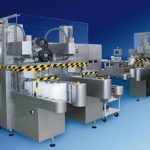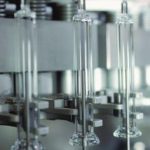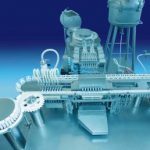Filling ready-to-use syringes with liquid medicines is a delicate process. The fragile glass containers must be transported through the production line with great care to prevent breakage. Bausch + Ströbel has developed a production line with a reject rate of <1 per 10 000 syringes. A particular feature of this line is the stress-free transport which prevents material strain in the transfer areas from the syringe rinser through the sterilizing tunnel to the filling and closing machine.
Bausch and Ströbel in Ilshofen (Germany) designs and constructs a comprehensive range of machines for the pharmaceutical industry. The modern modular construction method permits the assembly of the individual machines to complete processing lines. For virtually any capacity range, machines are available to rinse, sterilize, fill, close, inspect and label the containers, which might be ampoules, vials, bottles, cartridges or syringes as required. For a Swiss pharmaceutical company Bausch and Ströbel has designed and built a complete syringe processing line handling individual syringes. The line cleans and sterilizes the syringes and then fills a drug used for cancer therapy and to treat anaemia. „To suit the available floor space we designed a space-saving U-shaped line“, explained Harald Harlaß, head of the design team for the heart of the line, which includes the filling and closing machine. The line has a capacity of 24 000 syringes per hour which corresponds to an annual output of about 50 million syringes. The order was placed in August 2004 and the finished line acceptance at the Bausch + Ströbel factory took place in November 2005. When the line has been delivered and installed, and the isolator over the filling machine has been assembled, validation can begin. Production start is planned for the middle of 2006.
Loading the syringes
The syringes are delivered by the glass manufacturer in plastic trays which are loaded manually into the first machine. As the plastic trays are oriented alternately for better stacking, every other tray must be turned through 180° so that all the syringes can be removed the right way round. The tray is advanced underneath a vertical plastic wheel with suction cups which transfers the syringes to a second wheel above. From there they are fed into the feed track to the rinsing machine.
In the rinsing machine the syringes are turned upside-down and then rinsed with purified water and blown dry. This cleaning process is repeated several times but with WFI. Before leaving the machine a silicone emulsion is sprayed into the syringe interior. During the subsequent sterilization in the tunnel it is baked into a silicone layer which ensures that the plunger stopper in the syringe slides smoothly and continuously when the injection is administered. Parallel rows of 32 syringes are loaded into the sterilizing tunnel by a robot.
Sterilization
Inside the sterilizing tunnel the syringes are conveyed through the pre-heating zone to the sterilizing zone. During the transport they are heated gently and above all stress-free to the sterilizing temperature of 280 °C. The actual depyrogenation process takes approximately six minutes during which the silicone is also baked. Finally they are transported through the cooling zone where they are cooled to room temperature. At the tunnel exit a robot transfers the syringes to the filling and closing machine.
Filling and closing
When the machine is set up at its final destination, the work area of the filling and closing machine is enclosed in an isolator which guarantees aseptic production conditions according to cleanliness class A (ISO class 5). The articles required to close the syringes – such as OVS caps, needle assemblies and plunger stoppers – are supplied to the isolator interior through special ports without impairing sterility. Before starting the filling process the syringe needles are checked to ensure the passage is clear and not blocked by excess silicone emulsion in the sterilizing tunnel. Then either a needle assembly (needle with needle shield) or an OVS cap is applied. The drug is filled at an 8-head dosing station. For In-Process Control eight syringes are taken out by a robot arm and placed on the adjacent scales prior to filling to determine the tare weight. Then a gap is created in the syringe supply so that the syringes on the scales can be filled. When the gross weight has been determined, the next gap in the supply is used to return the syringes to the transport system so that they continue through the filling and closing machine. In order to close the syringe hermetically a plunger stopper is inserted. In the conventional stopper insertion method the stopper is pushed into the syringe through a tube which is slimmer than the syringe so that the air in the syringe barrel can escape. The syringe is squeezed radially in the process. This procedure normally presents no problems. „The cancer therapy drug, however, must not come into contact with the stopper material“, explained the project manager Bernd Wieland. For this reason the lower face of the stopper was coated with PTFE. „With the conventional insertion method there is a risk that the PTFE layer might tear when the stopper is squeezed, with the result that the drug does come into contact with the stopper material“, Wieland continued. „So Bausch + Ströbel has developed a vacuum assisted system to close the syringe.“ With this system the syringe barrel is docked hermetically to an evacuation bell and the air above the drug is drawn off. The stopper can then be inserted without being squeezed. With this method, residual oxygen in the syringe is below 2 %. After an optical check the processed syr-inges leave the isolator through the so-called mousehole.
Packing
The syringes are then transported to the tray-loading machine where the syringes are laid into the plastic trays. This transport system also serves as a buffer and overcomes the height difference between the filling and closing machine and the tray loader. The filled trays are removed and supplied to the labeling and secondary packaging line. (br)
cpp 462
The world of Bausch + Ströbel
Share:









